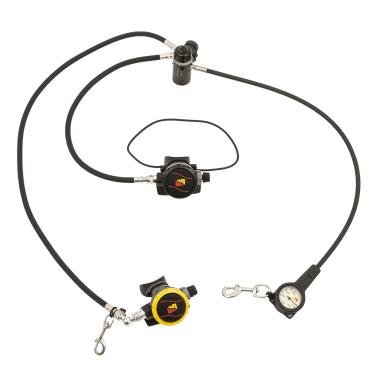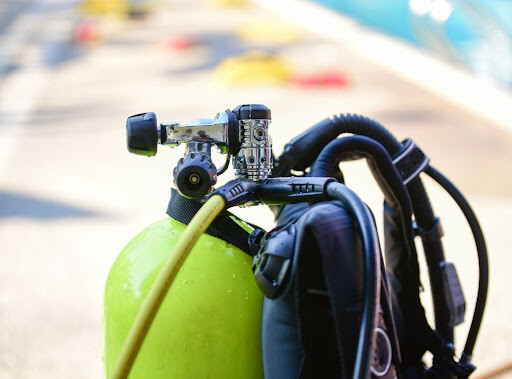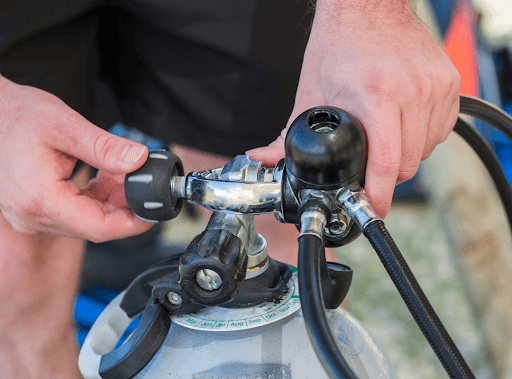Scuba diving regulators play a vital role in ensuring that the diver receives air at the appropriate pressure while diving. One of the most common questions about choosing a scuba diving regulator is, “Do I want a piston first stage or a diaphragm first stage regulator for diving?”
So what is best when it comes to diaphragm versus piston scuba diving regulators? To determine the answer to these questions, we’ll cover the real difference between the two, and as a buyer, what factors you should pay attention to when adding a scuba diving regulator to your scuba gear collection.

What Does A Scuba Regulator Do In Scuba Diving?
The first stage diving regulator connects directly to the scuba tank and converts the high pressure of the scuba tank to an intermediate pressure that your second stage can handle. By reducing the high-pressure air to an intermediate pressure, it allows for smooth and controlled airflow to the second stage scuba diving regulator, ensuring the diver can breathe comfortably underwater.
In most regulators for diving the IP (intermediate pressure) for your dive regulator is typically set between 135 psi and 150 psi (roughly 9 – 10 bar). The first stage scuba diving regulator feeds your primary second stage diving regulator, octopus, SPG, LP inflator, and any other accessory that is gas fed.
What Is The Difference Between Piston First Stage Scuba Regulators and Diaphragm First Stage Dive Regulators?

It’s all in the name! A piston first stage scuba diving regulator uses a piston that moves up and down against a large heavy tensioned spring.
How a Piston Regulator for Diving Works
When the piston regulator is pressurized by opening in the tank, the piston moves and allows air to pass the high pressure seat. Once the pressure inside the regulator reaches IP, then it closes, and air stops flowing. When you take a breath, it moves and allows air through.
With piston regulators, there are two types: balanced and unbalanced regulators. A balanced piston first stage will provide the same IP all the way down until the tank reaches the IP. An unbalanced regulator will have some IP drop as the pressure in the tank decreases. In most cases, the balanced first stage would cost more than the same regulator in an unbalanced design.
How Does a Diaphragm Scuba Diving Regulator Work?
A diaphragm first stage diving regulator differs fom a piston regutor by using a thick piece of rubber (this is the diaphragm.) This diaphragm is pressed up against a precision machined metal pin seated on a spring and then the hard plastic high pressure seat. There is also a spring pushing on the diaphragm from the opposite direction holding it closed.
When high pressure gas is introduced into the diaphragm regulator, the spring against the plastic high pressure seat opens, and gas flows into the second chamber of the regulator until the IP is reached. Then the regulator “closes” and this process repeats as you breathe. The diaphragm design is easily balanced, and today, you’d be hard pressed to find an unbalanced diaphragm for your first stage diving regulator.
Diaphragm vs Piston: The Pros and Cons of Each Type of Scuba Regulator

Which one, which one… trust us, we know it’s hard to decide. While diaphragm regulators and piston regulators are both commonly used in scuba diving equipment to regulate the flow of air from the scuba tank to the diver’s mouth, let’s review the pros and cons of each to see which scuba diving regulator is a perfect fit for your style of scuba diving!
Diaphragm Regulators for Diving
Some people might tell you that diaphragms don’t have as much airflow as a piston regulator. While this may be true, there wouldn’t be a noticeable difference in most sport diving (including technical) applications. But let’s dive into the pros and cons of diaphragm regulators!
Pros of a Diaphragm Regulator:
- Fully Sealed: Diaphragm regulators are designed with a sealed chamber that prevents water and contaminants from entering inside, making them more resistant to freezing at lower temperatures and a great option for a cold-water diving regulator.
- Durability and Longevity: Diaphragm scuba diving regulators are typically more durable than piston regulators by having fewer moving parts that can be impacted by internal corrosion. Durable inside and out, their hardiness allows them to have the added benefit of product longevity.
- Low Maintenance: Diaphragm regulators are relatively easy to maintain and service. They can be disassembled and cleaned without special tools, which can be extremely helpful when diving in remote locations, in emergencies, and when you’d like to decrease the amount of your travel gear.
Cons of Diaphragm Regulators:
- Breathing Sensitivity: Some divers find that diaphragm regulators require slightly more inhalation effort compared to piston regulators, especially during deeper dives or when breathing from an alternate air source. Consider your experience level and breathing technique before purchasing.
- Performance at Depth: While diaphragm regulators may experience a slight drop in performance at extreme depths due to the natural increase in ambient pressure, modern diving regulator designs have resolved this to a large extent.
Top 3 Diaphragm Regulators at DRIS:
- Apeks diaphragm regulators: utilize a unique “overbalanced” design. This means the intermediate pressure supplied to the second stage increases more than traditional balanced models as the diver descends to greater depths.
- Aqualung Leg3nd Elite: With exceptional cold-water performance, Aqua Lung’s Leg3nd Elite offers amazing antifreeze properties. The LEG3ND’s integrated dry chamber keeps inner components clean and dry by isolating them from the outside environment. Complete with deep ribs, this creates a large heat exchange surface area that helps to prevent ice forming on the mechanism.
- Scubapro MK19 Evo / A700: The MK19 EVO / A700 takes our extraordinary breathing A700 and pairs it with an environmentally sealed MK19 EVO first stage that’s extremely resistant to freezing. The air balanced second stage valve smoothes out the inhalation effort when diving at varying depths and supply pressures to deliver effortless inhalation and exhalation that is unmatched. Easy-to-use, the adjustable inhalation effort knob lets you achieve maximum, personalized comfort underwater.
 Pros and Cons of Piston Regulators as Scuba Gear
Pros and Cons of Piston Regulators as Scuba Gear
While the piston regulator is simple in design, can provide for high gas flow, and is less expensive to maintain, there is the possibility of freezing up in extremely cold water. This failure often causes the regulator to fail to “open” and free-flow uncontrollably. Read on to see the other main advantages and disadvantages of piston diving regulators.
Pros of Piston Regulators:
- Increased Breath Sensitivity: Piston regulators generally offer excellent breathing sensitivity. This means that inhalation at various depths and pressures feels easier, allowing divers to enjoy their dive and feel more comfortable underwater.
- Performance at Depth: Piston regulators tend to maintain consistent performance at extreme depths and under high ambient pressures, making them suitable for technical diving or deep dives.
Cons of Piston Regulators:
- Water Contamination: Piston regulators are more susceptible to water and debris contamination due to their design. When dirt and debris can enter, this will affect the performance of your diving regulator, lead to frequent maintenance and cleaning, and increase costs.
- Freezing Risk: The design of piston regulators makes them more prone to freezing in cold-water conditions with lower water temperatures. When ice forms, it can disrupt the movement of internal diving regulator components, increasing breathing resistance or even allowing a complete freeze-up to occur.
- Internal Corrosion: With more moving parts and exposed metal surfaces, piston regulators for diving are more susceptible to corrosion, especially if not properly and regularly maintained.
Top 3 Piston Regulators at DRIS:
- Atomic Aquatics T-3 regulator: the T-3 is environmentally sealed to keep out sand and salt from the piston, and help prevent freezing. Paired with a high-flow second stage case and lever design, the T-3 piston scuba diving regulator significantly lowers breathing effort all the way from shallow water to even deeper depths.
- Scuba Pro MK 25 EVO / A700: Patented XTIS (Extended Thermal Insulating System) thermally insulates the inner mechanism from the environment, improving cold-water resistance and delaying ice formation in extreme cold-water conditions without compromising breathing performance. Antifreeze protection radically increases breathing reliability when diving in the most extreme water temperatures while the external intermediate pressure adjustment enables you to fine-tune your breathing performance in balmy waters of the tropics or ice cold plunges.
- Atomic M1: With automatic flow control, the exclusively patented Atomic Aquatics feature automatically adjusts your airflow at depth to maintain stable, comfortable breathing. Perfect for cold water diving, the first stage is environmentally sealed to prevent entry of water or contaminants while the second stage features a thermal heat sink and improved super-dry exhaust valve.
Ultimately, the choice between diaphragm regulators and piston regulators depends on various factors such as the diving environment, personal preference, and specific diving requirements. Both types of scuba diving regulators have undergone significant advancements in design and technology, and either can provide reliable and safe breathing performance when properly maintained and serviced.
Scuba Regulator Repair Service
We supply it and we can service it! While we have an excellent regulator diving selection, DRIS also offers in-house scuba regulator repair.
By design, diaphragm regulators have more moving parts than piston regulators, meaning service kits might cost slightly more than a piston design. But on the other hand, diaphragm regulators are better for those who are not as meticulous with cleaning their first stage regulator after diving. They’re also good in all water temperatures, as the inner workings are not exposed directly to the water.
Regardless of which you choose, when you need a scuba regulator repair service be sure to contact DRIS. Our scuba diving repair experts will help you get you back to using your scuba diving regulator in no time!
We truly are a one-stop dive shop. Whether for your regulator, BCD, drysuit, or tank, DRIS is happy to help you get the most out of your dive gear. See what happens to your scuba regulator when you have it serviced at DRIS!
DRIS Is A Breath of Fresh Air When It Comes To Scuba Diving Regulators
Whether through our service or our selection of scuba diving regulators, we’re happy to help. Breathing underwater is no simple feat. Whichever regulator you decide to get, DRIS has a wide selection of both piston and diaphragm scuba regulators to fit how you dive.
You can rest easy knowing your favorite local dive shop, Dive Right In Scuba, can provide the best service, selection, and repairs to get your diving regulator setup just right. With years of diving experience, the highest accreditations, and free shipping from our Plainfield and Orlando Park locations, our 24/7 customer service representatives are ready to get you back underwater.
So don’t wait – let’s chat! Contact us today to review our full scuba diving regulator selection.
